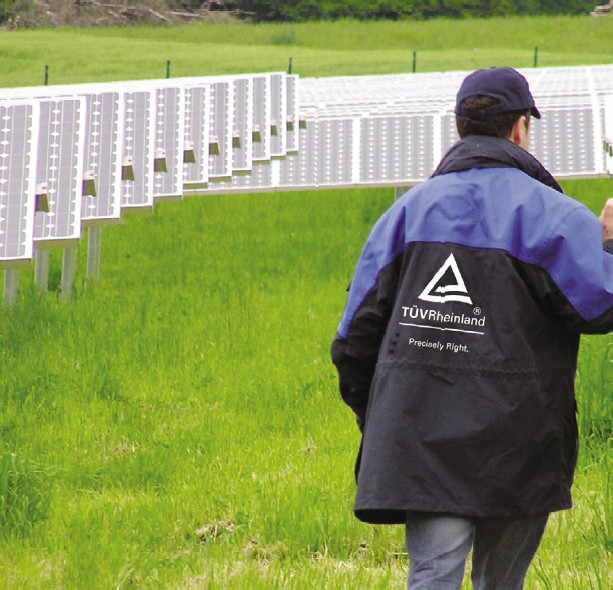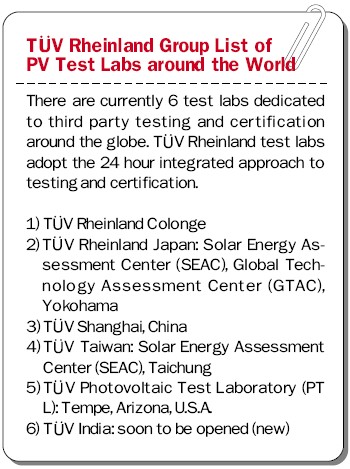By Luke P. Johnson

PV testing and certification is viewed from a variety of angles from within the PV industry depending on where the viewer is positioned. Some component manufacturers complain that it makes the whole industry less efficient. Buyers see it as an important differentiating factor between manufacturers. From the view of the certifier, we see it as necessary, but also understand that some inefficiency can always be improved upon.
However, PV modules need to be designed to last as one of their important aims is to reduce dependence on non-renewable energy. Test labs are now moving beyond the tests of the IEC standards and now developing benchmark testing and harsher criteria. This has been driven to a certain extent by manufacturers pursuing greater quality to differentiate their products in the market. Other new technologies are entering the market at an increasing rate, third party testing and certification is therefore changing for the particular needs of these new manufacturers. These new market entrants need to be carefully analyzed and categorized into the most appropriate standards that are available for testing whether that be IEC (International Electrotechnical Commission), UL (Underwriters Laboratories) or even particular standards only available in some countries if the technology is very new to the PV manufacturing world.
IEC Standards
To understand the complexities of the international standards takes time and some experience. There are two performance standards in the IEC; IEC61215 2nd Ed. and IEC61646 1st Ed. The IEC61215 standard is for crystalline PV modules. At the moment we are testing according to the second edition of this standard, however the working group of the IEC committee has already published a draft third edition to this standard. Some have already or are implementing some slight changes to test procedures. However, no completely new tests are added in the third edition. The IEC61646 2nd Ed., standard concentrates on thin-film PV modules, and it is written in such a way to cover the basket of thin-film technologies. However, test labs use their experience with solar simulator measurement methods to test according to the IEC60904 series of standards strictly. This enables all thin-film performance measurements to be done accurately and with higher reproducibility and repeatability. In reality, we are worried that not enough experience or strict adherence to the IEC60904 series of standards results in too much difference in measurement between test labs. More understanding of the calibration procedure for solar simulators is required in this case and stricter adherence even for some solar simulator manufacturers is required. It has been shown that the variation in maximum power between labs with round-robin measurements can be up to 6-8%. Until the information is disseminated through the industry, manufacturers will need to choose their test lab carefully when requesting calibration measurements.
California Electrical Commission Certification
In addition to the IEC standards, the recent growth of the U.S. market, especially in California, has driven manufacturers around the world to request certification of the California Electrical Commission (CEC). They need this if they want to export into this market. This is an additional test requirement on top of the IEC standards, as a strict power range of ±5% is required instead of the IEC standards of ±10% criteria. Also careful measurement and analysis of Nominal Operating Cell temperature (NOCT) is required.

UL Standard
In terms of the total U.S. market, the UL1703 standard from UL is required for manufacturers; this standard shares most of its tests with the IEC61730 standard and concentrates on safety aspects, however in addition to the IEC standard, some extra tests will need to be performed, for example, the water-spray test and sharp edge testing among others. Some other tests such as the temperature test has additional hotspot requirements included in the UL1703 standard and test labs will need to follow this method carefully in order to test properly. UL is not the only organization that can certify this standard as any test lab with an accredited UL1703 scope extension can also certify it. Some within the industry are still worried about being the first to use other test labs outside UL to certify this standard. However, by the end of the year it will be known that this can be done with the first examples expected to be completed by then. This can decrease some of the bottleneck in the industry.
New Standards
In terms of new standards that have arisen in the industry, the IEC62108 1st edition standard is being adopted by some test labs. The first manufacturers have already completed the testing and certification according to the standard and the path is opening up for more to follow. In Asia, manufacturers are expressing interest in this new and developing technology.
Testing & Certifying BIPV Modules
For new crystalline module technologies, BIPV (Building Integrated Photovoltaics) modules are starting to emerge in PV testing and certification. Depending on the particular nature of the BIPV module and how it is intended to fit into the building, the fire test will need to be added. Many test labs have either neglected implementing the fire test into their testing and certification of the IEC61730 standard or sub-contracted this test due to the need for additional infrastructure. BIPV modules are an area whereby depending on the unique nature of each BIPV manufacturer, particular testing and certification solutions need to be applied to cover the safety aspects.

New PV Technologies
Due to the harder market conditions for manufacturers using amorphous silicon and tandem structures, the number of new market entrants is consolidating. However, already well-positioned thin-film manufacturers have continued testing. Amorphous silicon and amorphous tandem structures are common among the new technologies being tested. Also a number of new CIGS technologies are undergoing testing and certification. Other new module structures such as O-shaped modules using CIGS technology and others that are sometimes harder to categorize into a particular standard are entering testing and certification. The latter may sometimes be fit into either flat-plate or concentrator standards depending upon the interpretation of the standard. Test labs are looking ahead and preparing themselves for the increasing complexity to implement measurement methods for all of these new technologies. In the case of organic dye-sensitized solar cells, test labs need to work directly with the manufacturer to optimize the testing methods for this technology based on the JIS (Japanese Industrial Standard) that is available, however we are waiting for the implementation of this standard into the IEC world.
Supertesting
One particular element that can be elaborated upon is the “Supertesting” benchmark performance. TUV Rheinland is now focusing on test criteria that are demanding quality beyond the IEC performance and safety standards. The benchmark test sequence is named “Supertesting” In TUV Rheinland, we have developed and presented these new methods into third party testing and evaluation for PV modules.
It has been shown in some circumstances that the IEC61215 2nd Ed. the IEC61730-1 1st Ed. and IEC61730-2 1st Ed. standards only approximate a basic level of quality for PV modules. Supertesting aims to forge a benchmark for PV modules that undertake a much harsher IEC standard-based test sequence. Back in 2009, we set out to design and implement this new test sequence and it has since been widely adopted.
The benchmark sequence has been designed not to be changed, however in addition to the basis sequence, additional add-on modules can be requested by the manufacturer. We intend to work strongly with the manufacturer according to their needs when developing these extra modules.
In some tests the modules that have entered a Supertest sequence will undergo tests that are up to 4-6 times the severity of the IEC standard-based test, criteria.
Manufacturers are given periodically updated test reports when the modules complete test ”blocks” that are a part of the whole Supertest sequence. Within these reports are detailed statements and information about Pmax variation over the completed test block and the whole sequence. If a module is evaluated to not adhere to IEC standard-based test criteria at any point, of this test sequence, the worst case will be recorded for this model. At this point the test lab informs the manufacturer of the suspected reasons for failure and paths needed to improve the stability of the model, so changes can be integrated. A new model can then be evaluated by the manufacturer and resubmitted for a new Supertest sequence and a path to improve the quality of the model will arise.
Manufacturers that undergo the strict criteria of the Supertest sequence will be able to test their technology to the strictest limits currently available in the PV module testing world. In summary, this is a new innovation in the third party testing world for PV and it supports development of greater quality for the PV industry.
It is some of our homework to strive for more stable production, better quality and stricter criteria so that the overall outcome for the PV industry is a positive one and the overall long-term impact on the world lingers. There is still a long way to go.
Luke P. Johnson is a Project Engineer at TUV Rheinland Japan and technical specialist. Johnson focuses on projects from North Asia for crystalline modules and on testing beyond IEC standards with benchmark “Supertesting” for special requests and developing new test procedures for new standards. In addition, he is responsible for the operation of the short pulse solar simulator testing and calibration for maximum power determination. Johnson also has an interest ranging from thin-film, CPV and high-efficiency crystalline testing and certification.
For more information, please send your e-mails to pved@infothe.com.
ⓒ www.interpv.net All rights reserved
|



